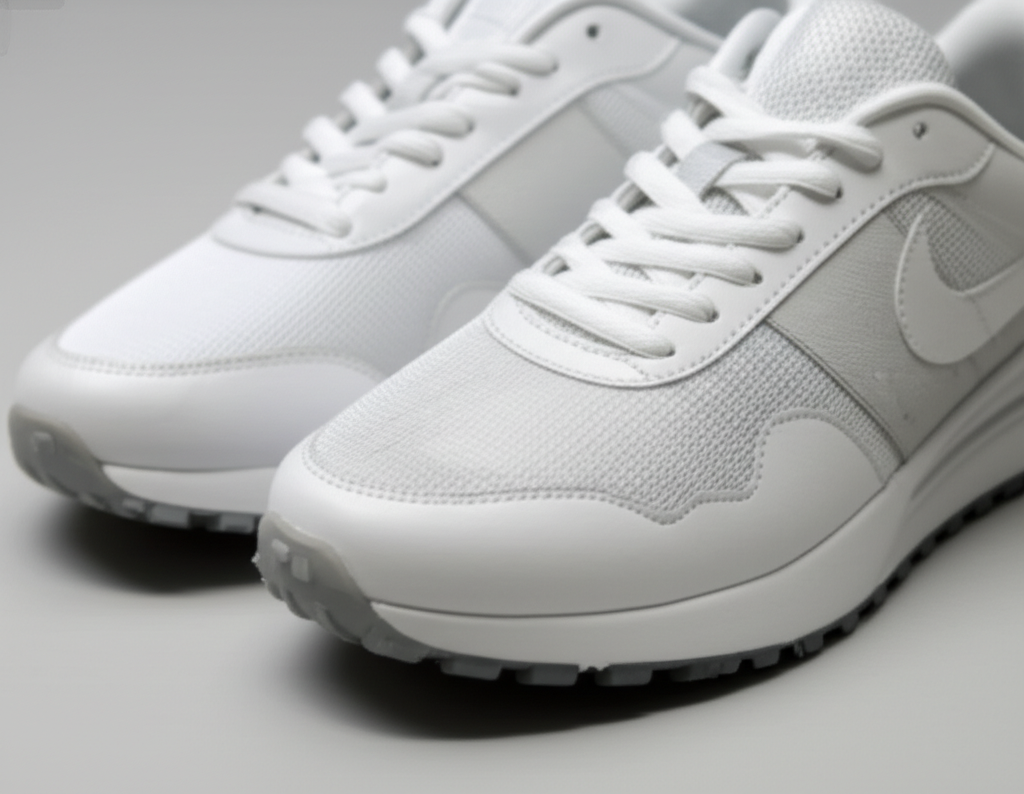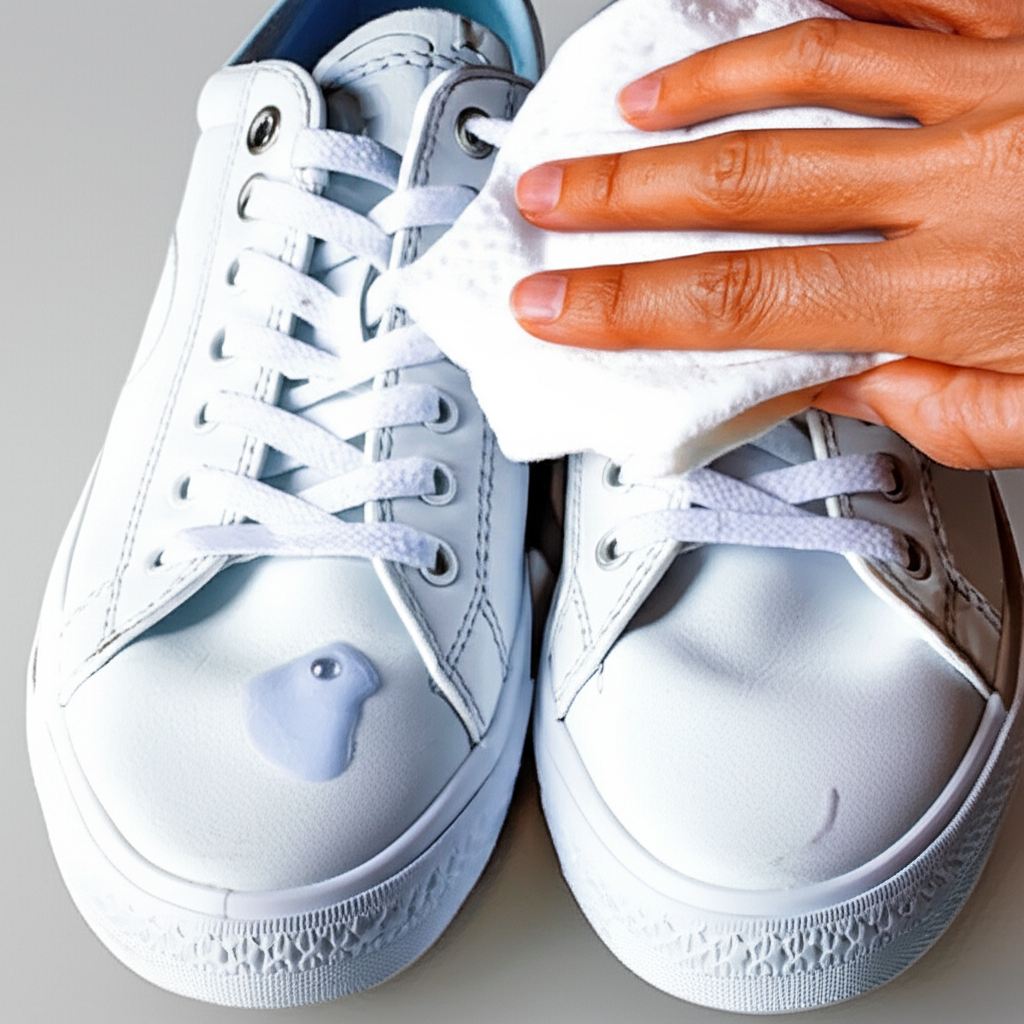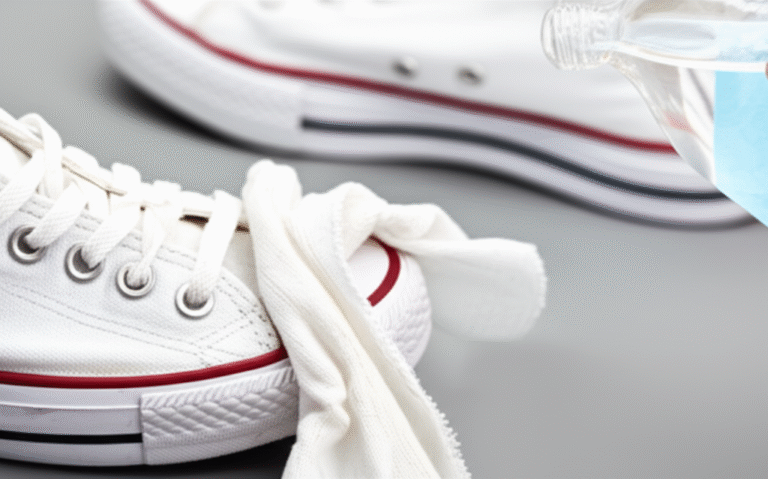Yes, hydrogen peroxide can effectively clean many types of shoes, tackling tough stains, yellowing, and odors with amazing results. This common household item is a surprisingly powerful, yet gentle, cleaner for various shoe materials when used correctly.
Key Takeaways
- Hydrogen peroxide cleans and whitens shoe soles.
- It tackles tough stains on fabric and rubber.
- Always test on an inconspicuous area first.
- Dilute for delicate materials like leather.
- Use it to combat shoe odor effectively.
- It’s a budget-friendly cleaning solution.
Does Hydrogen Peroxide Clean Shoes? Amazing Results!
Are your favorite sneakers looking a little worse for wear? Do you have stubborn scuffs or a yellowing tinge on the soles that just won’t budge? Many of us struggle to keep our shoes looking fresh and clean. The good news is, you might already have a secret weapon in your cleaning cabinet: hydrogen peroxide. This common household liquid is incredibly versatile, and when it comes to shoe care, it can deliver truly amazing results. But how does it work, and is it safe for all your footwear? Let’s dive into the science and the practical steps to get your shoes sparkling again.
Understanding Hydrogen Peroxide for Shoe Cleaning

Hydrogen peroxide (H₂O₂) is a chemical compound that’s similar to water but has an extra oxygen atom. This extra oxygen atom makes it unstable and highly reactive. When it comes into contact with organic materials or certain stains, it acts as an oxidizer. This means it can break down the chemical bonds that make up stains, effectively lifting them away. It also has mild bleaching properties, which is why it’s great for whitening yellowed rubber soles.
For shoe cleaning, we typically use a 3% solution, which is readily available at most pharmacies and supermarkets. Higher concentrations can be too harsh and might damage shoe materials. The beauty of hydrogen peroxide is its ability to disinfect and deodorize, too. The oxygen it releases can kill odor-causing bacteria and break down odor molecules, leaving your shoes smelling fresh.
It’s important to remember that while effective, hydrogen peroxide isn’t a miracle cure for every shoe problem. The best results depend on the type of shoe material, the nature of the stain, and the correct application method. We’ll explore which materials respond best and how to use it safely.
What Kind of Shoes Can Hydrogen Peroxide Clean?
Hydrogen peroxide is a versatile cleaner, but its effectiveness and safety vary depending on the shoe material. Here’s a breakdown of common shoe types and how well hydrogen peroxide works on them:
Sneakers and Athletic Shoes
This is where hydrogen peroxide truly shines. Most sneakers are made from materials like canvas, mesh, synthetic leather, and rubber. Hydrogen peroxide is excellent for:
- Whitening Rubber Soles: Over time, the white rubber parts of sneakers can turn yellow due to oxidation, UV exposure, and dirt. Hydrogen peroxide is one of the most effective ways to reverse this yellowing.
- Removing Scuffs and Stains: It can lift dirt, grass stains, mud, and scuff marks from the fabric and rubber components.
- Freshening Uppers: For canvas or mesh uppers, a diluted solution can help brighten them and remove light stains.
Caution: Be careful with colored fabrics or delicate materials on the uppers. Always test in an inconspicuous spot first, as peroxide can lighten colors.
Canvas Shoes (e.g., Converse, Vans)
Canvas shoes are generally very porous and can absorb stains easily. Hydrogen peroxide is a great option for cleaning them:
- Stain Removal: It helps break down common canvas stains like dirt and grass.
- Whitening: Excellent for making white canvas shoes look brighter and whiter.
- Sole Cleaning: Just like with sneakers, it brightens the rubber soles.
Tip: For heavily soiled canvas, you might need multiple applications or a slightly stronger paste made with baking soda and hydrogen peroxide.
Leather Shoes (Smooth Leather)
Hydrogen peroxide can be used on smooth leather, but with extreme caution and always diluted. Its oxidizing properties can dry out leather if used undiluted or too frequently.
- Light Stain Removal: For minor water spots or scuffs on lighter-colored smooth leather, a very lightly dampened cloth with a diluted solution can help.
- Cleaning White Leather: It can help brighten white leather shoes, but it’s crucial to follow up with a leather conditioner.
Caution: Never use on suede, nubuck, or patent leather. It can strip the finish, cause discoloration, or create permanent marks.
Suede and Nubuck Shoes
Do not use hydrogen peroxide on suede or nubuck shoes. These materials have a delicate nap (fuzzy texture) that hydrogen peroxide will damage, leading to stiffening, discoloration, and loss of texture. Specialized suede cleaners are necessary for these types of shoes.
Synthetic Leather and Vinyl Shoes
Hydrogen peroxide can be effective on synthetic leather and vinyl, which are less porous and less prone to drying out than genuine leather.
- Surface Cleaning: It can remove dirt and scuffs from the surface.
- Brightening: Helps restore the original sheen to white synthetic materials.
Important: Always use a diluted solution and wipe clean with a damp cloth afterward.
How to Use Hydrogen Peroxide to Clean Your Shoes: Step-by-Step Guide

Ready to give your shoes a new lease on life? Here’s a simple, effective method for using hydrogen peroxide. We’ll focus on cleaning the rubber soles and tackling common stains on fabric uppers, as these are the most common and successful applications.
What You’ll Need:
- 3% Hydrogen Peroxide solution
- Old toothbrush or small scrub brush
- Clean cloths (microfiber works best)
- Bowl
- Gloves (optional, but recommended to protect skin)
- Masking tape or painter’s tape (for protecting delicate parts)
- Baking soda (optional, for tough stains/yellowing)
- Cotton balls or pads (optional)
Step 1: Prepare Your Shoes and Workspace
First, remove the shoelaces and insoles if possible. This allows for a more thorough cleaning. If the insoles are heavily soiled or smelly, you can clean them separately. Use a damp cloth to wipe away any loose dirt or debris from the shoes. Lay down some old newspaper or a towel to protect your work surface.
Pro Tip: If you’re only cleaning the rubber soles and want to protect the fabric uppers from potential bleaching or discoloration, use masking tape to carefully cover the edges where the sole meets the upper.
Step 2: Tackle Yellowed Rubber Soles
This is where hydrogen peroxide really works wonders. The most popular method involves a paste:
- In a bowl, mix about 1 tablespoon of baking soda with enough 3% hydrogen peroxide to form a thick paste.
- Apply the paste generously to the yellowed rubber soles using an old toothbrush or your gloved fingers. Make sure to cover all the affected areas.
- (Optional but recommended for stubborn yellowing) Wrap the soles tightly with plastic wrap or place the shoes in a plastic bag. This helps keep the paste moist and allows the peroxide to work more effectively.
- Leave the shoes in direct sunlight for a few hours. The UV rays from the sun enhance the oxidizing power of the hydrogen peroxide, speeding up the whitening process. Check periodically.
- Once you see the yellowing has significantly reduced, use the toothbrush to scrub away the paste and any remaining grime.
- Rinse the soles thoroughly with water.
- Wipe the soles clean with a damp cloth.
If you don’t have baking soda or want a simpler method for less severe yellowing:
- Dampen a cloth or cotton ball with 3% hydrogen peroxide.
- Wipe down the rubber soles thoroughly.
- Let it sit for 15-30 minutes.
- Scrub with a toothbrush and rinse.
Step 3: Clean Fabric Uppers (Canvas, Mesh)
For fabric uppers, it’s best to dilute the hydrogen peroxide to avoid bleaching colored areas.
- Mix equal parts 3% hydrogen peroxide and water in a bowl.
- Dip an old toothbrush or a clean cloth into the diluted solution.
- Gently scrub the stained areas of the uppers. Work in small sections.
- For tougher stains, you can try applying the paste from Step 2 (baking soda and hydrogen peroxide) to the fabric, but be very careful with colored materials. Always test on a hidden spot first!
- After scrubbing, use a clean cloth dampened with plain water to wipe away the peroxide solution and any loosened dirt.
- Repeat if necessary for stubborn stains.
Step 4: Clean Smooth Leather or Synthetic Uppers (Use Sparingly!)
If you’re cleaning white smooth leather or synthetic uppers, use a highly diluted solution.
- Mix 1 part 3% hydrogen peroxide with 4 parts water.
- Dampen a soft cloth or cotton pad with the diluted solution. Do not saturate.
- Gently wipe the surface of the leather or synthetic material. Avoid scrubbing vigorously.
- Immediately wipe the area with a clean, damp cloth to remove any residual peroxide.
- For genuine leather, follow up with a suitable leather conditioner once the shoes are dry to restore moisture.
Step 5: Drying Your Shoes
Proper drying is crucial to prevent damage and odors.
- Stuff the shoes with clean, dry cloths or paper towels to absorb excess moisture and help them maintain their shape.
- Air dry your shoes completely at room temperature, away from direct heat sources like radiators or prolonged direct sunlight (unless you were intentionally using the sun for the sole whitening).
- Never put shoes in a clothes dryer, as the heat can warp adhesives and materials.
- Once completely dry, re-lace your shoes and replace the insoles.
The Science Behind the Shine: Why Hydrogen Peroxide Works
The effectiveness of hydrogen peroxide as a shoe cleaner comes down to its chemical properties, primarily its oxidizing power. Here’s a simplified look at the science:
- Oxidation: Hydrogen peroxide (H₂O₂) readily releases an oxygen atom (O). This free oxygen atom is highly reactive and can break down the chemical bonds of stain molecules and discolored compounds. Think of it like rust forming on metal – that’s oxidation. In cleaning, we harness this to break down unwanted compounds.
- Bleaching Effect: The release of oxygen also has a mild bleaching effect. This is particularly useful for breaking down chromophores – the parts of a molecule responsible for color. This is why it can lighten yellowed rubber and brighten white fabrics. For more detail on oxidation reactions in cleaning, resources like the American Chemical Society offer insights into the chemical processes involved.
- Disinfection and Deodorizing: The unstable oxygen molecule can also react with and neutralize odor-causing bacteria and volatile organic compounds (VOCs) that create smells. This is why hydrogen peroxide can help make shoes smell fresher.
The effectiveness is amplified by physical action (scrubbing) and environmental factors (like sunlight, which can accelerate the reaction). However, it’s the chemical reaction of oxidation that does the heavy lifting.
Pros and Cons of Using Hydrogen Peroxide for Shoe Cleaning
Like any cleaning method, using hydrogen peroxide has its advantages and disadvantages. Understanding these can help you decide if it’s the right choice for your shoes.
Pros:
Here are the benefits of using hydrogen peroxide:
- Effective Stain Removal: Excellent for tackling common shoe stains like dirt, grass, and mud, especially on white or light-colored shoes.
- Whitens Yellowed Soles: It’s one of the best home remedies for reversing the yellowing of rubber midsoles and outsoles.
- Deodorizes: Helps kill odor-causing bacteria and neutralize smells, leaving shoes fresher.
- Affordable: A 3% hydrogen peroxide solution is inexpensive and widely available.
- Readily Available: You likely already have it in your medicine cabinet.
- Eco-Friendly (Relatively): Breaks down into water and oxygen, making it less harmful than some harsher chemical cleaners.
Cons:
Here are the drawbacks to consider:
- Can Discolor/Bleach: May lighten or remove color from dyed fabrics, colored leather, or certain synthetic materials. Always test first!
- Can Damage Delicate Materials: Not suitable for suede, nubuck, patent leather, or delicate fabrics like silk.
- Dries Out Leather: Can strip natural oils from genuine leather if used undiluted or too often, leading to cracking.
- Requires Sunlight (for best sole results): The most effective method for yellowing often requires UV exposure, which isn’t always practical.
- Potential for Residue: If not rinsed properly, a slight film might remain, though this is rare with proper cleaning.
Here’s a quick comparison table:
| Aspect | Hydrogen Peroxide (3%) | Other Cleaners (e.g., specialized shoe cleaner) |
|---|---|---|
| Effectiveness on Yellowing Soles | Excellent (especially with sun) | Varies, some are very effective |
| Stain Removal (General) | Good to Very Good | Good to Excellent |
| Deodorizing | Good | Good to Excellent |
| Safety on Suede/Nubuck | No – Damages | No – Requires specialized cleaners |
| Safety on Smooth Leather | Use diluted, cautiously; can dry | Generally safe with appropriate leather cleaners |
| Cost | Very Low | Low to Moderate |
| Availability | High | Moderate (shoe stores, online) |
Alternative Methods and When to Use Them
While hydrogen peroxide is a fantastic option for many shoe cleaning tasks, it’s not the only solution. Sometimes, other methods or cleaners are more appropriate.
- For Delicate Materials (Suede, Nubuck): Use a dedicated suede brush and eraser. For tough stains, specialized suede cleaner sprays or foams are best. Never use water or liquid cleaners directly on these materials without specific product guidance.
- For General Cleaning (All Shoe Types): A mild soap (like dish soap) mixed with water is a good all-around cleaner for uppers. Use a soft brush or cloth.
- For Tough Stains on Colored Fabrics: A specialized fabric stain remover might be safer than hydrogen peroxide, which can cause bleaching. Always check the product label for material compatibility.
- For Deep Cleaning and Disinfection: Some sneaker cleaning kits include specialized solutions that are formulated for specific materials and offer powerful cleaning without harsh side effects.
- For Oily or Greasy Stains: Cornstarch or baking soda can be sprinkled on fresh grease stains to absorb the oil before cleaning.
When in doubt, always refer to the manufacturer’s care instructions for your specific shoes. Reputable sources like WikiHow offer comprehensive guides on cleaning various shoe types, which can supplement your hydrogen peroxide efforts.
Frequently Asked Questions (FAQ)
Can I use hydrogen peroxide on colored canvas shoes?
Yes, but with extreme caution. Always dilute the hydrogen peroxide with water (at least 1:1 ratio) and test it on an inconspicuous area first, like the inside tongue or near the sole, to ensure it doesn’t cause the color to fade or bleach.
How long should I leave hydrogen peroxide on the soles?
For yellowed soles using the baking soda paste method, leaving it in direct sunlight for 2-6 hours is often recommended. For a quick wipe-down, 15-30 minutes might be sufficient for lighter yellowing. Always monitor the process and rinse when you see improvement.
Will hydrogen peroxide damage the glue in my shoes?
Typically, a 3% solution of hydrogen peroxide, especially when diluted and rinsed properly, is unlikely to damage the adhesives used in most shoes. However, prolonged exposure or using stronger concentrations could potentially weaken glue over time. Always rinse thoroughly.
Is hydrogen peroxide safe for the environment?
Hydrogen peroxide breaks down into water and oxygen, which are environmentally benign. This makes it a much safer option than many other harsh chemical cleaners. However, like any chemical, it’s best to use it responsibly and avoid excessive runoff.
Can I use hydrogen peroxide to remove ink stains from shoes?
Hydrogen peroxide can sometimes help with ink stains, especially on white or light-colored materials. Apply a small amount of diluted solution to a cotton swab and dab directly onto the ink. Blot with a clean cloth. For stubborn ink, specialized ink removers might be necessary.
Should I wear gloves when using hydrogen peroxide?
It’s a good idea to wear gloves, especially if you have sensitive skin or are using it for extended periods. While a 3% solution is generally safe, prolonged contact can cause dryness or mild irritation to the skin.
Conclusion
So, does hydrogen peroxide clean shoes? Absolutely! With its potent oxidizing properties, it’s a remarkably effective and affordable solution for tackling yellowed rubber soles, stubborn stains on canvas and mesh, and even general freshening up of many types of footwear. Its ability to disinfect and deodorize adds to its appeal as a go-to shoe cleaner.
Remember the golden rules: always test on an inconspicuous area first, dilute for colored or delicate materials, and never use it on suede or nubuck. By following the step-by-step guides and understanding its capabilities, you can achieve amazing results and keep your favorite shoes looking their best for longer. Happy cleaning!

